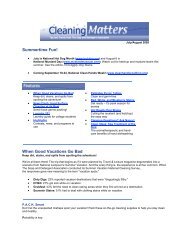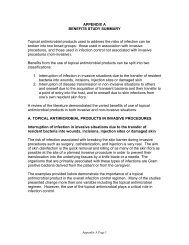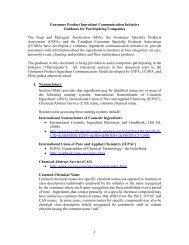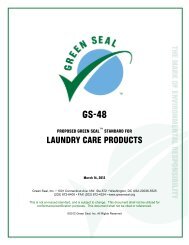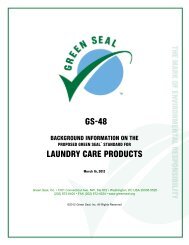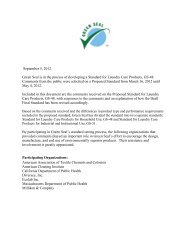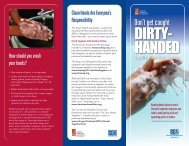subchapter c -- federal hazardous substances act regulations
subchapter c -- federal hazardous substances act regulations
subchapter c -- federal hazardous substances act regulations
Create successful ePaper yourself
Turn your PDF publications into a flip-book with our unique Google optimized e-Paper software.
16 CFR Ch. II (1–1–05 Edition) – proposed modification – 6/25/06<br />
of a substance to which there is human<br />
exposure will differ from those char<strong>act</strong>eristics<br />
for the substance tested in the studies used to<br />
define the dose-response relationship.<br />
(ii) In determining the need to assess<br />
bioavailability, the f<strong>act</strong>ors to be examined<br />
include:<br />
(A) The physical or chemical form of the<br />
substance,<br />
(B) The route of exposure (inhalation,<br />
ingestion, or through the skin),<br />
(C) The presence of other constituents in<br />
the product which interfere with or alter<br />
absorption of the toxic substance, and<br />
(D) Dose.<br />
(3) Assessment of Risk. This section on<br />
quantitative risk assessment applies to<br />
estimates of risk for <strong>substances</strong> that are toxic<br />
by reason of their carcinogenicity.<br />
(i) Generally, the study leading to the<br />
highest risk should be used in the risk<br />
assessment; however, other f<strong>act</strong>ors may<br />
influence the choice of study.<br />
(ii) Risk should be based on the maximum<br />
likelihood estimate from a multistage model<br />
(such as Global83 or later version) unless the<br />
maximum likelihood estimate is not linear at<br />
low dose, in which case the 95% upper<br />
confidence limit on risk should be used.<br />
(iii) For systemic carcinogens, if estimates<br />
of human risk are made based on animal data,<br />
a f<strong>act</strong>or derived from dividing the assumed<br />
human weight (70 kg) by the average animal<br />
weight during the study and taking that to the<br />
1 / 3 power should be used. There is the<br />
possibility that this f<strong>act</strong>or may be changed,<br />
using the 1 / 4 power instead of the 1 / 3 power, as<br />
part of a unified Federal regulatory approach.<br />
If such an approach is adopted, it will apply<br />
here.<br />
(iv) When dose is expressed as parts per<br />
million, and the carcinogen <strong>act</strong>s at the site of<br />
cont<strong>act</strong>, humans and animals exposed to the<br />
same amount for the same proportion of<br />
lifetime should be assumed to be equally<br />
sensitive.<br />
(v) If no experimental study having the<br />
same route of exposure as that anticipated for<br />
human use of a substance is available, a study<br />
by another route of exposure may be used.<br />
Pharmacokinetic methods may be used if<br />
sufficient data are available.<br />
(vi) When exposure scenarios are different<br />
from those used in the underlying study upon<br />
-- 94 --<br />
which estimates of risk are based,<br />
proportionality should be applied. If<br />
pharmacokinetic methods are used to adjust<br />
for risks at high versus low exposure levels,<br />
level-time measures should not be combined<br />
without taking the non-linearity into account.<br />
(4) Acceptable Risks -- (i) ADI for<br />
Carcinogens. The maximum acceptable daily<br />
intake (“ADI”) is that exposure of a toxic (by<br />
virtue of its carcinogenicity) substance that is<br />
estimated to lead to a lifetime excess risk of<br />
one in a million. Exposure refers to the<br />
anticipated exposure from normal lifetime use<br />
of the product, including use as a child as well<br />
as use as an adult.<br />
(ii) ADI for Neurotoxicological and<br />
Developmental/Reproductive Agents. Due to<br />
the difficulties in using a numerical risk<br />
assessment method to determine risk for<br />
neurotoxicological<br />
or<br />
developmental/reproductive toxicants, the<br />
Commission is using a safety f<strong>act</strong>or approach,<br />
as explained below.<br />
(A) Human Data. If the hazard is<br />
ascertained from human data, a safety f<strong>act</strong>or of<br />
ten will be applied to the lowest No Observed<br />
Effect Level (“NOEL”) seen among the<br />
relevant studies. If no NOEL can be<br />
determined, a safety f<strong>act</strong>or of 100 will be<br />
applied to the Lowest Observed Effect Level<br />
(“LOEL”). Both the NOEL and LOEL are<br />
defined in terms of daily dose level.<br />
(B) Animal Data. If the hazard is<br />
ascertained from animal data, a safety f<strong>act</strong>or of<br />
one hundred will be applied to the lowest<br />
NOEL. If no NOEL can be determined, a<br />
safety f<strong>act</strong>or of one thousand will be applied to<br />
the lowest LOEL. Both the NOEL and LOEL<br />
are defined in terms of daily dose level.<br />
§ 1500.210 Responsibility.<br />
The provisions of these <strong>regulations</strong> (16 CFR<br />
<strong>subchapter</strong> C of chapter II) with respect to the<br />
doing of any <strong>act</strong> shall be applicable also to the<br />
causing of such <strong>act</strong> to be done.<br />
§ 1500.211 Guaranty.<br />
In the case of the giving of a guaranty or<br />
undertaking referred to in section 5(b)(2) of<br />
the <strong>act</strong>, each person signing such guaranty or<br />
undertaking, or causing it to be signed, shall<br />
be considered to have given it. Each person<br />
causing a guaranty or undertaking to be false is



